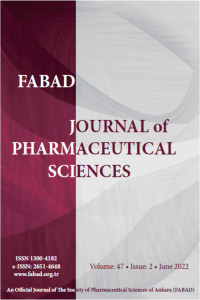Abstract
References
- Abdul-Fattah, A. M., & Bhargava, H. N. (2002).Preparation and in vitro evaluation of solid dispersions of halofantrine. International Journal of Pharmaceutics, 235(1-2), 17-33. https://doi. org/10.1016/s0378-5173(01)00941-3
Competency of Lyophilization and Spray Drying Techniques to Improve the Solubility of Bosentan Monohydrate: A Comparative Study
Abstract
The present study focused on comparing the efficacy of two novel
techniques, lyophilization and spray drying, which were proposed
to overcome the solubility drawbacks of the highly effective
antihypertensive drug, bosentan monohydrate. Solid dispersion
approach is the most globally acknowledged and successful method for
improving solubility. Poloxamer 188 was used as the carrier to prepare
the solid dispersions. The results indicated that the particle size,
solubility, and dissolution profiles of formulated amorphous systems
varied significantly. Lyophilized solid dispersions demonstrated
the highest level of solubility in the prepared solid dispersions.
The solid dispersion formulations FL10 and FS10 prepared using
lyophilization and spray drying techniques were optimized using
a 32 full factorial design approach. The resulting amorphous solid
dispersions were characterized using Fourier-transform infrared
spectroscopy (FTIR), particle size analysis, differential scanning
calorimetry (DSC), X-ray diffraction (XRD), scanning electron
microscopy (SEM), and transmission electron microscopy (TEM).
The optimized solid dispersion (FL10) prepared via lyophilization
had an average particle size of 450.9 nm in particle size analysis.
X-ray diffraction analyses of both FL10 and FS10 revealed a decrease
in peak intensity compared to the drug and polymer, indicating the
transformation of the crystalline form to amorphous. The outcomes of
this study allow us to conclude that even though lyophilization and
spray drying can be used to enhance solubility, lyophilization showed
superior results.
References
- Abdul-Fattah, A. M., & Bhargava, H. N. (2002).Preparation and in vitro evaluation of solid dispersions of halofantrine. International Journal of Pharmaceutics, 235(1-2), 17-33. https://doi. org/10.1016/s0378-5173(01)00941-3
Details
| Primary Language | English |
|---|---|
| Subjects | Pharmacology and Pharmaceutical Sciences |
| Journal Section | Research Article |
| Authors | |
| Publication Date | August 1, 2022 |
| Submission Date | September 9, 2021 |
| Published in Issue | Year 2022 Volume: 47 Issue: 2 |

